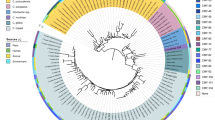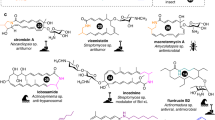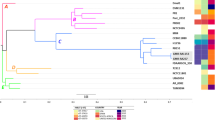Abstract
Strains 6105T and 6106, recovered from colonized patients in a hospital in Tel-Aviv, Israel, were compared with currently known species of the genus Citrobacter by a polyphasic taxonomic approach. Strains were characterized by whole-genome sequencing, 16S rRNA and recN gene sequencing, multilocus sequence analysis (MLSA), average nucleotide identity (ANI), Genome-to-Genome Distance Calculator (GGDC), and biochemical tests. The location and genetic surrounding of antibiotic resistance genes were investigated, and antibiotic susceptibility profiles were determined by broth microdilution or agar dilution methods. Phylogenetic analysis based on recN and MLSA revealed that both strains formed a distinct cluster from all currently recognized species. The ANI and GGDC were 90.7% and 54.3% with Citrobacter farmeri, respectively. The ability to metabolize various compounds also differentiated both strains from closely related Citrobacter species. Chromosomes of the isolates contained locus encoding a novel class A β-lactamase (TEL-1; 90.5% amino acid identity with CdiA of Citrobacter koseri) plus a LysR-like transcriptional regulator (TEL-R) and an ~ 25.5-kb mcr-9 mosaic region. The direct mcr-9 context matched with those previously identified in several plasmids and chromosomes of diverse Enterobacteriaceae, yet similarity with the plasmidic loci extended further. Untypeable plasmids, pCTEL-2 (~ 235 kb) and pCTEL-1 (~ 114 kb), devoid of resistance genes, were identified in the strains. The isolates were non-susceptible to β-lactams. The name Citrobacter telavivum sp. nov. is proposed, with 6105T (CECT 9989T or DSM 110286T) as the type strain. C. telavivum may represent a bacterial species adapting to hospital settings, able to disseminate and acquire antimicrobial resistance genes.


Similar content being viewed by others
Explore related subjects
Discover the latest articles and news from researchers in related subjects, suggested using machine learning.References
Clermont D, Motreff L, Passet V, Fernandez JC, Bizet C, Brisse S (2015) Multilocus sequence analysis of the genus Citrobacter and description of Citrobacter pasteurii sp. nov. Int J Syst Evol Microbiol 65:1486–1490
Ribeiro TG, Gonçalves BR, da Silva MS, Novais Â, Machado E, Carriço JA, Peixe L (2017) Citrobacter portucalensis sp. nov., isolated from an aquatic sample. Int J Syst Evol Microbiol 67:3513–3517
Ribeiro TG, Clermont D, Branquinho R, Machado E, Peixe L, Brisse S (2017) Citrobacter europaeus sp. nov., isolated from water and human faecal samples. Int J Syst Evol Microbiol 67:170–173
Ribeiro TG, Novais Â, Branquinho R, Machado E, Peixe L (2015) Phylogeny and comparative genomics unveil independent diversification trajectories of qnrB and genetic platforms within particular Citrobacter species. Antimicrob Agents Chemother 59:5951–5958
Börjesson S, Greko C, Myrenås M, Landén A, Nilsson O, Pedersen K (2019) A link between the newly described colistin resistance gene mcr-9 and clinical Enterobacteriaceae isolates carrying bla(SHV-12) from horses in Sweden. J Glob Antimicrob Resist 20:285–289
Liu YY, Wang Y, Walsh TR, Yi LX, Zhang R, Spencer J, Doi Y, Tian G, Dong B, Huang X, Yu LF, Gu D, Ren H, Chen X, Lv L, He D, Zhou H, Liang Z, Liu JH, Shen J (2016) Emergence of plasmid-mediated colistin resistance mechanism MCR-1 in animals and human beings in China: a microbiological and molecular biological study. Lancet Infect Dis 16:161–168
Lima WG, Alves MC, Cruz WS, Paiva MC (2018) Chromosomally encoded and plasmid-mediated polymyxins resistance in Acinetobacter baumannii: a huge public health threat. Eur J Clin Microbiol Infect Dis 37:1009–1019
Carroll LM, Gaballa A, Guldimann C, Sullivan G, Henderson LO, Wiedmann M (2019) Identification of novel mobilized colistin resistance gene mcr-9 in a multidrug-resistant, colistin-susceptible Salmonella enterica serotype Typhimurium isolate. MBio 10:e00853–e00e19
Chavda KD, Westblade LF, Satlin MJ, Hemmert AC, Castanheira M, Jenkins SG, Chen L, Kreiswirth BN (2019) First report of bla (VIM-4)- and mcr-9-coharboring Enterobacter species isolated from a pediatric patient. mSphere 4:e00629–e00e19
Kieffer N, Royer G, Decousser JW, Bourrel AS, Palmieri M, Ortiz De La Rosa JM, Jacquier H, Denamur E, Nordmann P, Poirel L (2019) mcr-9, an inducible gene encoding an acquired phosphoethanolamine transferase in Escherichia coli, and its origin. Antimicrob Agents Chemother 63:e00965–e00e19
Yuan Y, Li Y, Wang G, Li C, Xiang L, She J, Yang Y, Zhong F, Zhang L (2019) Coproduction of MCR-9 and NDM-1 by colistin-resistant Enterobacter hormaechei isolated from bloodstream infection. Infect Drug Resist 12:2979–2985
Bilavsky E, Temkin E, Lerman Y, Rabinovich A, Salomon J, Lawrence C, Rossini A, Salvia A, Samso JV, Fierro J, Paul M, Hart J, Gniadkowski M, Hochman M, Kazma M, Klein A, Adler A, Schwaber MJ, Carmeli Y, MOSAR WP5 study team (2014) Risk factors for colonization with extended-spectrum β-lactamase-producing Enterobacteriaceae on admission to rehabilitation centres. Clin Microbiol Infect 20:O804–O810
Izdebski R, Baraniak A, Fiett J, Adler A, Kazma M, Salomon J, Lawrence C, Rossini A, Salvia A, Vidal Samso J, Fierro J, Paul M, Lerman Y, Malhotra-Kumar S, Lammens C, Goossens H, Hryniewicz W, Brun-Buisson C, Carmeli Y, Gniadkowski M, MOSAR WP2 and WP5 Study Groups (2013) Clonal structure, extended-spectrum β-lactamases, and acquired AmpC-type cephalosporinases of Escherichia coli populations colonizing patients in rehabilitation centers in four countries. Antimicrob Agents Chemother 57:309–316
Zankari E, Hasman H, Cosentino S, Vestergaard M, Rasmussen S, Lund O, Aarestrup FM, Larsen MV (2012) Identification of acquired antimicrobial resistance genes. J Antimicrob Chemother 67:2640–2644
Richter M, Rosselló-Móra R, Oliver Glöckner F, Peplies J (2016) JSpeciesWS: a web server for prokaryotic species circumscription based on pairwise genome comparison. Bioinformatics 32:929–931
Meier-Kolthoff JP, Auch AF, Klenk HP, Göker M (2013) Genome sequence-based species delimitation with confidence intervals and improved distance functions. BMC Bioinformatics 14:60
Kumar S, Stecher G, Tamura K (2016) MEGA7: Molecular Evolutionary Genetics Analysis version 7.0 for bigger datasets. Mol Biol Evol 33:1870–1874
Saitou N, Nei M (1987) The neighbor-joining method: a new method for reconstructing phylogenetic trees. Mol Biol Evol 4:406–425
Kimura M (1980) A simple method for estimating evolutionary rates of base substitutions through comparative studies of nucleotide sequences. J Mol Evol 16:111–120
Felsenstein J (1985) Confidence limits on phylogenies: an approach using the bootstrap. Evolution 39:783–791
Warren JR, Farmer JJ 3rd, Dewhirst FE, Birkhead K, Zembower T, Peterson LR, Sims L, Bhattacharya M (2000) Outbreak of nosocomial infections due to extended-spectrum beta-lactamase-producing strains of enteric group 137, a new member of the family Enterobacteriaceae closely related to Citrobacter farmeri and Citrobacter amalonaticus. J Clin Microbiol 38:3946–3952
Meier-Kolthoff JP, Hahnke RL, Petersen J, Scheuner C, Michael V, Fiebig A, Rohde C, Rohde M, Fartmann B, Goodwin LA, Chertkov O, Reddy T, Pati A, Ivanova NN, Markowitz V, Kyrpides NC, Woyke T, Göker M, Klenk HP (2014) Complete genome sequence of DSM 30083(T), the type strain (U5/41(T)) of Escherichia coli, and a proposal for delineating subspecies in microbial taxonomy. Stand Genomic Sci 9:2
Tyson GH, Li C, Hsu CH, Ayers S, Borenstein S, Mukherjee S, Tran T-T, McDermott PF, Zhao S. 2020. The mcr-9 gene of Salmonella and E. coli is not associated with colistin resistance in the United States. Antimicrob Agents Chemother. 64:e00573–20
Kananizadeh P, Oshiro S, Watanabe S, Iwata S, Kuwahara-Arai K, Shimojima M, Ogawa M, Tada T, Kirikae T (2020) Emergence of carbapenem-resistant and colistin-susceptible Enterobacter cloacae complex co-harboring blaIMP-1 and mcr-9 in Japan. BMC Infect Dis 20:282
Ambler RP, Coulson AF, Frère JM, Ghuysen JM, Joris B, Forsman M, Levesque RC, Tiraby G, Waley SG (1991) A standard numbering scheme for the class A beta-lactamases. Biochem J 276:269–270
Perilli M, Franceschini N, Segatore B, Amicosante G, Oratore A, Duez C, Joris B, Frère JM (1991) Cloning and nucleotide sequencing of the gene encoding the β-lactamase from Citrobacter diversus. FEMS Microbiol Lett 67:79–84
Jones ME, Avison MB, Damdinsuren E, MacGowan AP, Bennett PM (1994) Heterogeneity at the β-lactamase structural gene ampC amongst Citrobacter spp. assessed by polymerase chain reaction analysis: potential for typing at a molecular level. J Med Microbiol 41:209–214
Petrella S, Clermont D, Casin I, Jarlier V, Sougakoff W (2001) Novel class A β-lactamase Sed-1 from Citrobacter sedlakii: genetic diversity of β-lactamases within the Citrobacter genus. Antimicrob Agents Chemother 45:2287–2298
Ainala SK, Ashok S, Ko Y, Park S (2013) Glycerol assimilation and production of 1,3-propanediol by Citrobacter amalonaticus Y19. Appl Microbiol Biotechnol 97:5001–5011
Sheppard AE, Stoesser N, Wilson DJ, Sebra R, Kasarskis A, Anson LW, Giess A, Pankhurst LJ, Vaughan A, Grim CJ, Cox HL, Yeh AJ, Modernising Medical Microbiology (MMM) Informatics Group, Sifri CD, Walker AS, Peto TE, Crook DW, Mathers AJ (2016) Nested Russian doll-like genetic mobility drives rapid dissemination of the carbapenem resistance gene blaKPC. Antimicrob Agents Chemother 60:3767–3778
Mathers AJ, Crook D, Vaughan A, Barry KE, Vegesana K, Stoesser N, Parikh HI, Sebra R, Kotay S, Walker AS, Sheppard AE (2019) Klebsiella quasipneumoniae provides a window into carbapenemase gene transfer, plasmid rearrangements, and patient interactions with the hospital environment. Antimicrob Agents Chemother 63:e02513-18
Barry KE, Wailan AM, Sheppard AE, Crook D, Vegesana K, Stoesser N, Parikh HI, Sebra R, Mathers AJ (2019) Don’t overlook the little guy: an evaluation of the frequency of small plasmids co-conjugating with larger carbapenemase gene containing plasmids. Plasmid 103:1–8
Thiel S, Bunk B, Spröer C, Overmann J, Jahn D, Biedendieck R (2019) Complete genome sequence of Raoultella electrica 1GB (DSM 102253T), isolated from anodic biofilms of a glucose-fed microbial fuel cell. Microbiol Resour Announc 8:e00800–e00819
Witzel K, Gwinn-Giglio M, Nadendla S, Shefchek K, Ruppel S (2012) Genome sequence of Enterobacter radicincitans DSM16656(T), a plant growth-promoting endophyte. J Bacteriol 194:5469
Zurfluh K, Stephan R, Klumpp J, Nüesch-Inderbinen M, Hummerjohann J, Bagutti C, Marti R (2017) Complete genome sequence of Citrobacter freundii 705SK3, an OXA-48-encoding wastewater isolate. Genome Announc 5:e00842–e00817
Kizny Gordon A, Phan HTT, Lipworth SI, Cheong E, Gottlieb T, George S, Peto TEA, Mathers AJ, Walker AS, Crook DW, Stoesser N (2020) Genomic dynamics of species and mobile genetic elements in a prolonged blaIMP-4-associated carbapenemase outbreak in an Australian hospital. J Antimicrob Chemother 75:873–882
Funding
The study isolates were collected within activities of the MOSAR project (LSHP-CT-2007-037941) supported by the European Commission. This work received financial support from Applied Molecular Biosciences Unit UCIBIO, supported by national funds from FCT/MCTES (UIDB/04378/2020), and from the National Medicines Institute in Warsaw, Poland (grant no. DS-4.41/2018-19).
Author information
Authors and Affiliations
Corresponding author
Ethics declarations
The study was approved by the Ethic Committee of the Tel Aviv Sourasky Medical Center, Tel-Aviv, Israel.
Conflict of interest
The authors declare that they have no conflict of interest.
Additional information
Publisher’s note
Springer Nature remains neutral with regard to jurisdictional claims in published maps and institutional affiliations.
Electronic supplementary material
ESM 1
(PDF 384 kb)
Rights and permissions
About this article
Cite this article
Ribeiro, T.G., Izdebski, R., Urbanowicz, P. et al. Citrobacter telavivum sp. nov. with chromosomal mcr-9 from hospitalized patients. Eur J Clin Microbiol Infect Dis 40, 123–131 (2021). https://doi.org/10.1007/s10096-020-04003-6
Received:
Accepted:
Published:
Issue Date:
DOI: https://doi.org/10.1007/s10096-020-04003-6




